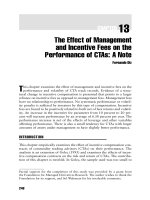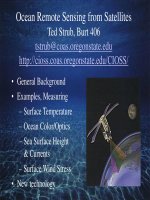Geography and Oceanography - Chapter 13 pps
Bạn đang xem bản rút gọn của tài liệu. Xem và tải ngay bản đầy đủ của tài liệu tại đây (4.93 MB, 41 trang )
Ocean Surface Circulation
Motion in the Ocean, Part I, or Why
does the ocean have currents, and
why do they move in circles?
Jack Barth ()
NASA web site: Two types of Ocean Circulation:
➨
Surface Circulation Wind-driven
➨
Deep Circulation – Density-driven
Density of water is influenced by
Temperature and Salinity, so density-
driven circulation is often called the
“Thermohaline” Circulation
Friday’s lecture
Atmospheric Circulation
Temperature and Pressure
✦
As the Earth’s surface is heated, air is
warmed, expands and rises (Low Pressure)
✦
Warm air carries water vapor
✦
In the upper atmosphere the air cools and
sinks (High Pressure)
✦
Surface winds blow from High Pressure to
Low Pressure
✦
This round-trip is called a “cell”
Things get interesting!
➨
On a rotating planet, moving objects
appear to be deflected
➨
Why is this?
Coriolis Deflection
✦
Apparent force due to Earth’s rotation
✦
Deflection in path of motion when viewed from
a rotating reference frame
✦
Gustave-Gaspard Coriolis (1835)
✦
Familiar from merry-go-rounds
✦
Significant only for large distances
(not toilets and billiards!)
animation
northern hemisphere), unforced particle
in motion is deflected to the
right
.
If frame rotates CW, motion of particle is
to the
left
(reverse film).
velocity
Coriolis Force
(northern
hemisphere)
velocity
Coriolis Force
(southern
hemisphere)
Coriolis Deflection
“During the naval engagement near the Falkland Islands
which occurred early in World War I, the British gunners
were surprised to see their accurately aimed salvos falling
100 yards to the left of the German ships. The designers
of the sighting mechanisms were well aware of the
Coriolis deflection and had carefully taken this into
account, but they apparently were under the impression
that all sea battles took place near 50°N latitude, and
never near 50°S latitude. The British shots, therefore, fell
at a distance from the targets equal to twice the Coriolis
deflection.”
Jerry B. Marion, “Classical Dynamics of Particles and
Systems”, 2
nd
edition, 1971.
Consequences of Coriolis
✦
Moving fluids (atmosphere and ocean)
turn to the right in the Northern
Hemisphere
✦
Moving fluids (atmosphere and ocean)
turn to the left in the Southern
Hemisphere
Global Wind Circulation
westerlies
trades
trades
westerlies
Wind-Driven Ocean Circulation
✦
Steady winds produce waves and set the
surface water in motion
✦
Moving water is deflected to the right
(N.Hemisphere) or left (S.Hemisphere)
✦
This starts the main “gyre” motion of
the surface ocean
Surface Ocean Circulation
Main Features
✦
Five large gyres
✦
Antarctic Circumpolar Current
✦
Equatorial Countercurrent
✦
Velocities vary fastest are meters/sec
Ocean Surface Current Speed
cm/second
How fast is a cm/second?
100 centimeters in a meter; 1000 meters in a kilometer
so 100,000 centimeters per kilometer
24 hrs x 3600 sec/hr = 86,400 sec~100,000 seconds per day
1 cm/second = 1 km/day
R. Lumpkin (NOAA/AOML)
10
6
m
3
/sec (Sverdrup) = all the rivers
Gulf Stream - Benjamin Franklin
1760s
Sailing times
to and from
Europe
Gulf Stream from satellite
So, do the gyres just
follow the winds?
✦
Not exactly! But the winds get the
motion in the ocean started
✦
The oceans respond by flowing and
turning
✦
Water piles up in the center of gyres
several meters high
Global Wind Circulation
westerlies
trades
trades
westerlies
Ekman Transport moves
water 90°to the winds
Ekman (1905)
Geostrophic Currents
Coriolis deflection plus the Pressure Gradient
steers the currents around the gyres
Northern Hemisphere Gyres
westward intensification
~1000
meters









